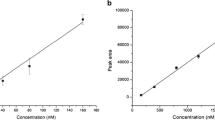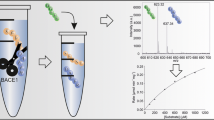Abstract
Formation of isoaspartate (IsoAsp) from spontaneous asparagine (Asn) deamidation or aspartate (Asp) isomerization is one of the most common non-enzymatic pathways of chemical degradation of protein and peptide pharmaceuticals. Rapid quantitation of IsoAsp formation can enable rank-ordering of potential drug candidates, mutants, and formulations as well as support shelf life prediction and stability requirements. A coupled enzymatic fluorescence-based IsoAsp assay (CEFIA) was developed as a high-throughput method for quantitation of IsoAsp in peptides and proteins. In this note, application of this method to two therapeutic candidate proteins with distinct structural scaffolds is described. In addition, the results obtained with this method are compared to those from conventional assays.





Similar content being viewed by others
Abbreviations
- Asp:
-
Aspartate
- IsoAsp:
-
Isoaspartate
- CEFIA:
-
Coupled enzymatic fluorescence-based IsoAsp assay
- TPM:
-
Tryptic peptide mapping
- PEG:
-
Polyethylene glycol
References
Aswad DW, Paranandi MV, Schurter BT. Isoaspartate in peptides and proteins: formation, significance, and analysis. J Pharm Biomed Anal. 2000;21(6):1129–36.
Stratton LP, Kelly RM, Rowe J, Shively JE, Smith DD, Carpenter JF, et al. Controlling deamidation rates in a model peptide: effects of temperature, peptide concentration, and additives. J Pharm Sci. 2001;90(12):2141–8.
Zhang W, Czupryn MJ. Analysis of isoaspartate in a recombinant monoclonal antibody and its charge isoforms. J Pharm Biomed Anal. 2003;30(5):1479–90.
Lindner H, Helliger W. Age-dependent deamidation of asparagine residues in proteins. Exp Gerontol. 2001;36(9):1551–63.
Cannon L, Butler F, Wan W, Zhou ZS. A stereospecific colorimetric assay for (S, S)-adenosylmethionine quantification based on thiopurine methyltransferase-catalyzed thiol methylation. Anal Biochem. 2002;308(2):358–63.
Liu M, Cheetham J, Cauchon N, Ostovic J, Ni W, Ren D, et al. Protein isoaspartate methyltransferase-mediated 18O-labeling of isoaspartic acid for mass spectrometry analysis. Anal Chem. 2012;84(2):1056–62.
Biastoff S, Teuber M, Zhou Z, Dräger B. Colorimetric activity measurement of a recombinant putrescine N-methyltransferase from Datura stramonium. Planta Med. 2006;72(12):1136–41.
Dorgan K, Wooderchak W, Wynn D, Karschner E, Alfaro J, Cui Y, et al. An enzyme-coupled continuous spectrophotometric assay for S-adenosylmethionine-dependent methyltransferases. Anal Biochem. 2006;350(2):249–55.
Hendricks C, Ross J, Pichersky E, Noel J, Zhou Z. An enzyme-coupled colorimetric assay for S-adenosylmethionine-dependent methyltransferases. Anal Biochem. 2004;326(1):100–5.
Hudec R, Hamada K, Mikoshiba K. A fluorescence-based assay for the measurement of S-adenosyl homocysteine hydrolase activity in biological samples. Anal Biochem. 2013;433(2):95–101.
Wang R, Ibanez G, Islam K, Zheng W, Blum G, Sengelaub C, et al. Formulating a fluorogenic assay to evaluate S-adenosyl-L-methionine analogues as protein methyltransferase cofactors. Mol BioSyst. 2011;7(11):2970–81.
Liu H, Wang F, Xu W, May K, Richardson D. Quantitation of asparagine deamidation by isotope labeling and liquid chromatography coupled with mass spectrometry analysis. Anal Biochem. 2013;432(1):16–22.
Zhang W, Czupryn MJ. Development of a strong cation-exchange high-performance liquid chromatography method for analysis of isoaspartate in proteins. Anal Biochem. 2002;307(1):184–6.
Carlson AD, Riggin RM. Development of improved high-performance liquid chromatography conditions for nonisotopic detection of isoaspartic acid to determine the extent of protein deamidation. Anal Biochem. 2000;278(2):150–5.
Schurter BT, Aswad DW. Analysis of isoaspartate in peptides and proteins without the use of radioisotopes. Anal Biochem. 2000;282(2):227–31.
McFadden P, Clarke S. Conversion of isoaspartyl peptides to normal peptides: implications for the cellular repair of damaged proteins. Proc Natl Acad Sci U S A. 1987;84(9):2595–9.
Author information
Authors and Affiliations
Corresponding author
Rights and permissions
About this article
Cite this article
Puri, A., Quan, Y., Narang, A.S. et al. A Fluorescence-Based High-Throughput Coupled Enzymatic Assay for Quantitation of Isoaspartate in Proteins and Peptides. AAPS PharmSciTech 18, 803–808 (2017). https://doi.org/10.1208/s12249-016-0570-7
Received:
Accepted:
Published:
Issue Date:
DOI: https://doi.org/10.1208/s12249-016-0570-7




